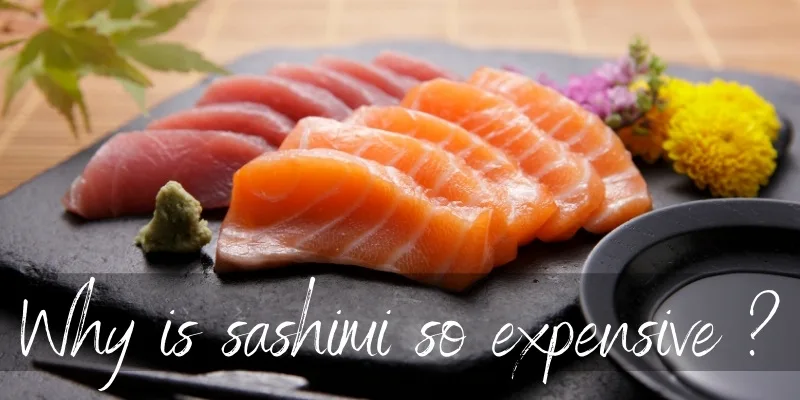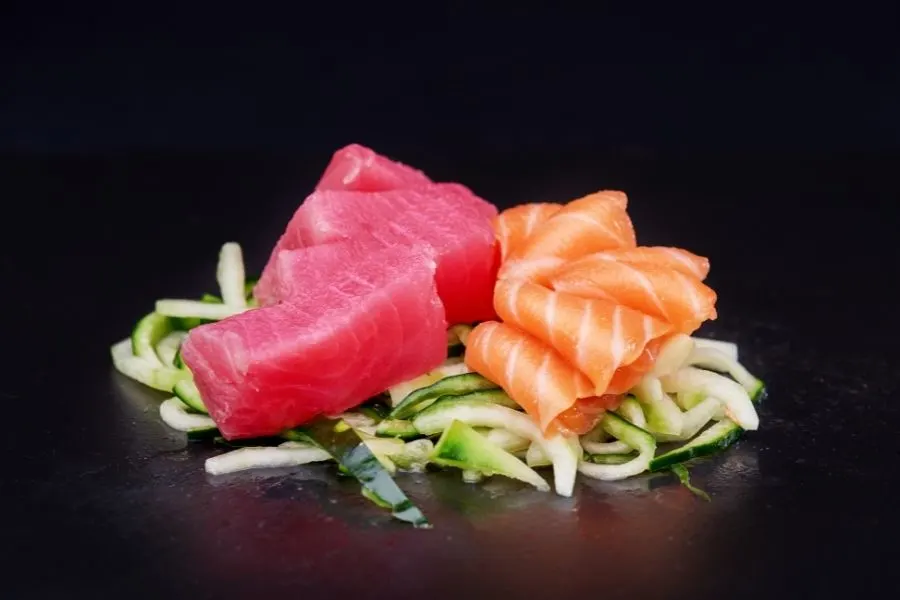If you’ve ever wondered why sashimi is so expensive then this post is for you. The question makes sense, because you’re getting the same fish you normally would get in a sushi, right ? It’s just all fish, no rice.
The truth is a little different, because while it’s the same fish type it’s a wholly different change in quality. There’s also many more variables for each fish type. Let’s take a closer look at what makes sashimi worth its money.

Why is sashimi so expensive ?
Sashimi is expensive because it requires the highest grade fish, be it fresh or aged for flavor, and a very well trained chef. Each individual fish is different, and knowing where and how to cut the delicate meat is both art and science.
Sashimi is a very simple meal, consisting of just delicate meat, soy sauce, wasabi, and pickled ginger. There is nothing to steal the spotlight off the fish, like other toppings or rice.
On a plate of sashimi you will notice two things: the absolute quality of the ingredients, and the chef’s skill. Let’s talk about this in a bit more detail, because you can find cheap sashimi too but it’s usually put together with supermarket ingredients. Those rarely go past the price of regular sushi. Let’s talk real sashimi.
1. Sashimi needs the highest quality meat
Probably the most important thing about sashimi is the meat quality. You can make or break a sashimi platter by the quality of the fish you use. How is quality determined ?
First, it’s about the fish itself. The most common are tuna and salmon, and sashimi-grade fish is caught by handline, individually. This way you get larger, better fish. The method of killing the fish is what makes it sashimi-grade though. A thin, shark spike is quickly run through the fish’s brain, killing it instantly. It’s a quick death, sparing the animal from pain and minimizing the lactic acid in the meat.

Read also: Why Is Nori So Expensive ?
Second, because the meat is low on lactic acid it doesn’t degrade as quickly as other meat types. So it’s still in a rush to get to restaurants and markets, but it has almost a week to be edible if kept on ice.
The fish caught for sashimi are not only larger and better exercised than commercial grade fish, they’re from less polluted waters. Since Japan is surrounded by water, bringing extra fresh fish is not a big problem. It’s outside of Japan that the problem of meat quality and freshness arises.
There’s also the timing to consider. When you order a particular sashimi type may hike the price up, because that particular fish may not be easily found.
So for example tuna is in season from early summer to late fall, and if you order it in January it may come at a higher cost. Each chef knows his fish very well and will be able tot ell you what is in season.
2. Chefs need to be very well trained
The way sashimi is cut actually sets up its flavor. Not all fish types are the same, and each has a recommended cutting style. The most common is the flat cut, like a piece of domino. You will usually find tuna and salmon cut this way, but more firmer fish need to be cut differently.
For example flounder or bream are cut much like you would cut a beef steak: across the grain diagonally, to make each fiber easier to chef through.
Aside form all this, each individual fish may need to be cut differently. The chef will analyze each piece of meat to determine what cut is the best for that particular fish type and its age.
This requires a whole lot of training, since you need more than just a sharp knife. It’s years of cutting meat and observing each particular style and how it melts in the mouth. No one likes a very chewy sashimi, so chef need to really know what they’re doing when they serve this.
In some areas you may find sashimi that is not fish, such as beef or chicken but these are not as common as the fish.
Sashimi resembles the Italian carpacchio in a way, as it relies on a piece of very good meat, fresh, and an amazing skill in cutting the meat.
3. There are no distractions in sashimi
Most of the time the sashimi is just the sliced meat, with the accompanying soy sauce and dips or seasonings. But there is no vegetable mix usually, and there is never any rice.
There’s nothing to distract your taste buds from a possibly poor sashimi meat. This means the stakes really are high, and if you’re in one of the older Japanese restaurants their reputation is at steak as well.
You see chefs take immense pride in their work, and sashimi is one of the best things they can make. It requires the most skill and it involves your experience as a client, form the moment you walk in until you walk out.
So a good sashimi is never just good, it’s great.
Read Also: Why Is Paella So Expensive?
Can sashimi make you sick ?
You may be apprehensive about sashimi, and we get it. It’s raw meat, fish or not, and it can pose its risk. The truth is yes, you can get sick from sashimi if the chef is not careful. Yet another reason they pay a lot of attention to their craft.
So what’s wrong with sashimi ? Well, the main problem is parasites. Be it fish or chicken, raw meat may harbor parasites, be they adult or just their eggs. Chicken sashimi for example is considered a delicacy, but can net you Salmonella.
Some salmon may get you tapeworm. Normally fish that have lived part of their lives in muddy, still waters are not used for sashimi. But some farmed salmon have been noted to harbor roundworm eggs, which normally get destroyed when the fish is cooked.
And of course, some meat may get treated with carbon monoxide to prevent oxidation. This means the meat will look fresh, even if it’s actually spoiling. This is why it really matters where the sashimi meat comes from.
A good chef will source his fish and meat from fresh markets, or may have a contract with fishermen to bring the fish to him directly. This way you can be sure the meat is fresh, but it may incur an even higher cost.
Sashimi is a delicacy, and needs to be prepared with a lot of care. The chef must be focused on the ingredients, how well they pair together, and the overall experience of the customer. All in all not an easy job.

